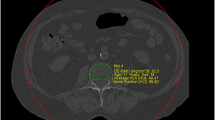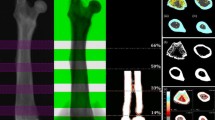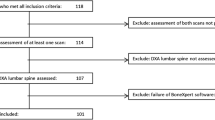Abstract
Lumbar spine bone mineral density (BMD) was measured by dual-energy X-ray absorptiometry (DXA) (Hologic QDR 1000) and by153Gd dual-photon absorptiometry (DPA) (Novo Lab 22a) in 120 postmenopausal women. Though a high correlation existed between the two techniques, the ratio between DXA and DPA values was not constant. Using DXA we observed a higher dependence of BMD on weight than in the DPA measurements. To investigate the different behaviour of DXA and DPA machines with weight, we analysed the effects of increasing thickness of soft tissue equivalents on the BMD of the Hologic spine phantom and on the BMD equivalent of an aluminium standard tube. Increasing tissue-equivalent thickness caused the phantom BMD measured by DPA to decrease significantly but had not effect on the DXA measurements. The different behaviour of DPA and DXA equipment with regard to the phantoms could account for the differences observed in the relations between BMD and weight in the patients. Using multiple regression we studied the influence of weight and body mass index on the relation between BMD measured by the two techniques. The introduction of either of these variables into the regression resulted in an improvement of the prediction of the DXA values from the DPA values. However, the residual standard error of the estimate was still higher than the combined precision errors of the two methods, so that no simple relation allows a conversion of BMDDPA into BMDDXA. Our results confirm that BMD is positively correlated with weight in postmenopausal women; the influence of weight on BMD is blunted when the Novo Lab 22a DPA machine is used for measuring bone mineral.
Similar content being viewed by others
References
Cameron JR, Sorensen J. Measurement of bone mineral in vivo: an improved method. Science 1963;142:230–2.
Wahner HW, Dunn WL, Mazess RB, et al. Dual-photon Gd-153 absorptiometry of bone. Radiology 1985;156:203–6.
Genant HK, Steiger P, Block JE, et al. Quantitative computed tomography: update 1987. Calcif Tissue Int 1987;41:179–86.
Sartoris DJ, Resnick D. Dual-energy radiographic absorptiometry for bone densitometry: current status and perspective. AJR 1989;152:241–6.
Mazess RB, Peppier WW, Chesney RW, et al. Does bone measurement on the radius indicate skeletal status? J Nucl Med 1984;25:281–8.
Wahner HW, Dunn WL, Riggs BL. Assessment of bone mineral: II. J Nucl Med 1984;25:1241–53.
Lindsay R, Fey C, Haboubi A. Dual-photon absorptiometric measurements of bone mineral density increase with source life. Calcif Tissue Int 1987:41:293–4.
Dunn WL, Kan SH, Wahner HW. Errors in longitudinal measurements of bone mineral: effect of source strength in single and dual-photon absorptiometry. J Nucl Med 1987;28:1751–7.
DaCosta MC, Luckey MM, Meier DE, et al. Effect of source strength and attenuation on dual-photon absorptiometry. J Nucl Med 1989;30:1875–80.
Slosman DO, Rizzoli R, Buchs B, et al. Comparative study of the performances of X-ray and gadolinium-153 bone densitometers at the level of the spine, femoral neck and femoral shaft. Eur J Nucl Med 1990;17:3–9.
Kelly TL, Slovik DM, Schoenfeld DA, et al. Quantitative digital radiography versus dual-photon absorptiometry of the lumbar spine. J Clin Endocrinol Metab 1988;67:839–44.
Glüer CC, Steiger P, Selvidge R, et al. Comparative assessment of dual-photon absorptiometry and dual-energy radiography. Radiology 1990;174:223–8.
Strause L, Bracker M, Saltman P, et al. A comparison of quantitative dual-energy radiographic absorptiometry and dual-photon absorptiometry of the lumbar spine in postmenopausal women. Calcif Tissue Int 1989;45:288–91.
Reginster JY, Albert A, Denis D, et al. Is fat mass a relevant protection against postmenopausal bone loss? In: Christiansen C, Johansen JS, Riis BJ, editors. Osteoporosis 1987. Viborg, Denmark: Nørhaven, 1987:632–4.
Stevenson JC, Lees B, Devenport M, et al. Determinants of bone density in normal women: risk factors for future osteoporosis? BMJ 1989;298:924–8.
Kelly P, Twomey L, Sambrook P, et al. Is the effect of weight on vertebral bone mineral density spurious? J Bone Miner Res 1990;5(Suppl 2):S110.
Garn SM, Leonard WR, Hawthorne VM. Three limitations of the body mass index. Am J Clin Nutr 1986;44:996–7.
Hansen MA, Hassager C, Overgaard K, et al. Dual-energy X-ray absorptiometry: a precise method of measuring bone mineral density in the lumbar spine. J Nucl Med 1990;31:1156–62.
Hassager C, Christiansen C. Influence of soft tissue body composition on bone mass and metabolism. Bone 1989;10:415–9.
Author information
Authors and Affiliations
Rights and permissions
About this article
Cite this article
Martin, P., Verhas, M., Als, C. et al. Influence of patient's weight on dual-photon absorptiometry and dual-energy X-ray absorptiometry measurements of bone mineral density. Osteoporosis Int 3, 198–203 (1993). https://doi.org/10.1007/BF01623676
Received:
Accepted:
Issue Date:
DOI: https://doi.org/10.1007/BF01623676




